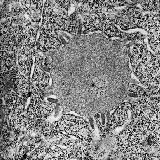Skip subpage navigation

Rabies is a preventable viral disease of mammals most often transmitted through the bite of a rabid animal. The vast majority of rabies cases reported to the Centers for Disease Control and Prevention each year occur in wild animals like raccoons, skunks, bats, and foxes. The rabies virus infects the central nervous system, ultimately causing disease in the brain and death. The early symptoms of rabies in people are similar to that of many other illnesses, including fever, headache, and general weakness or discomfort. As the disease progresses, more specific symptoms appear and may include insomnia, anxiety, confusion, slight or partial paralysis, excitation, hallucinations, agitation, hypersalivation (increase in saliva), difficulty swallowing, and hydrophobia (fear of water). Death usually occurs within days of the onset of these symptoms.
The rabies virus is transmitted through saliva or brain/nervous system tissue. You can only get rabies by coming in contact with these specific bodily excretions and tissues. It’s important to remember that rabies is a medical urgency but not an emergency. Decisions should not be delayed. Wash any wounds immediately. One of the most effective ways to decrease the chance for infection is to wash the wound thoroughly with soap and water.
For people who have never been vaccinated against rabies previously, post-exposure anti-rabies vaccination should always include administration of both passive antibody and vaccine. The combination of human rabies immune globulin and vaccine is recommended for both bite and non-bite exposures, regardless of the interval between exposure and initiation of treatment. People who have been previously vaccinated or are receiving pre-exposure vaccination for rabies should receive only vaccine.
You will find below all of the resources you will need about the rabies vaccine. More will be added as they are published or released.
You also may be interested in...
You are leaving Health.mil
The appearance of hyperlinks does not constitute endorsement by the Department of Defense of non-U.S. Government sites or the information, products, or services contained therein. Although the Defense Health Agency may or may not use these sites as additional distribution channels for Department of Defense information, it does not exercise editorial control over all of the information that you may find at these locations. Such links are provided consistent with the stated purpose of this website.
You are leaving Health.mil
View the external links disclaimer.
Last Updated: October 11, 2023